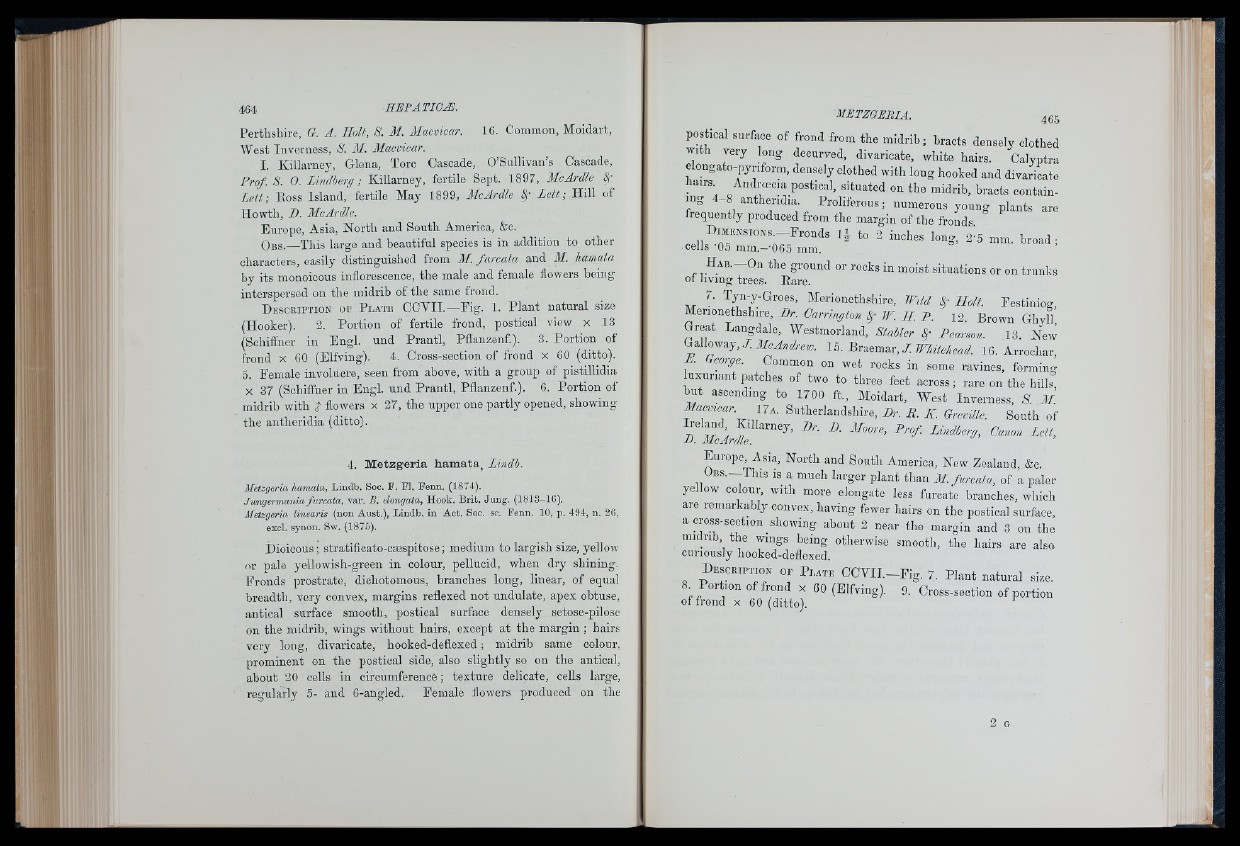
Pertlisbire, G. A. Holt, 8. M. Macvicar. 16. Common, Moidart,
West Inverness, S. M. Macvicar.
I. Killarney, Glena, Tore Cascade, O’Sullivan’s Cascade,
Prof. S. 0. Lindberg; Killarney, fertile Sept. 1897, McArdle fl
Lett; Eoss Island, fertile May 1899, McArdle fl Lett; Hill of
Howth, i). McArdle.
Europe, Asia, North and South America, &o.
O b s .—This large and beautiful species is in addition to other
charaoters, easily distinguished from M. fureata and M. liamata
by its monoicous inflorescence, the male and female flowers being
interspersed on the midrib of the same frond.
D e s c r ip t io n oe P la t e CCVII.—Eig. 1. Plant natural size
(Hooker). 2. Portion of fertile frond, postical view x IS
(Sohiffner in Engl, und Prantl, Pflanzenf.). 3. Portion of
frond X 60 (Elfving). 4. Cross-seotion of frond x 60 (ditto).
5. Female involucre, seen from above, with a group of pistillidia
X 37 (Scliiffner in Engl, und Prantl, Pflanzenf.). 6. Portion of
midrib with J flowers x 27, the upper one partly opened, showing
the antheridia (ditto).
4. Metzgeria hamata^ Lindh.
Metzgeria hamata, Lindb. Soc. F. Fl. Fenn. (1874).
.fungermania fureata, var. B. dongata, Hook. Brit. Jung. (1818-16).
Metzgeria linearis (non Aust.), Lindb. in Act. Soc. sc. Fenn. 10, p. 494, n. 26,
exol. synon. Sw. (1875).
Dioicous; stratificato-csespitose; medium to largish size, yellow
or pale yellowish-green in colour, pellucid, when dry shining.
Fronds prostrate, dichotomous, branohes long, linear, of equal
breadth, very convex, margins reflexed not undulate, apex obtuse,
antical surface smooth, postical surface densely setose-pilose
on the midrib, wings without hairs, except at the margin ; hairs
very long, divaricate, hooked-deflexed; midrib same colour,
prominent on the postical side, also slightly so on the antioal,
about 20 cells in circumference; texture delicate, cells large,
regularly 5- and G-angled. Female flowers produced on the
postical surface of frond from the midrib; bracts densely clothed
with very long deeurved, divaricate, white hairs. Calyptra
elongato-pyriform, densely clothed with long hooked and divaricate
flams Androecia postical, situated on the midrib, braots contain-
mg 8 antheridia. Proliferous; numerous young plants are
frequently produced from the margin of the fronds
DiMENSiONS^Fronds to 2 inches long, 2A mm. broad;
cells 05 mm.—'065 mm.
Hab.—On the ground or rocks in nioist situations or on trunks
ot Jiving trees. Eare.
Tyn-y-Groes, Merionethshire, IFdd fl Ilolt. Festiniog,
Merionethshire, Dr. Carrington fl IF. H. P. 12. Brown Ghyll
Great Langdale, Westmorland, Stabler fl Pearson. 13. New’
GA\owi,j,.LMcAmlreiv. 15. Brnoma.v,J. Whitehead. 16. Arrochar,
A George. Common on wet rocks in some ravines, forming
uxiiriant patches of two to three feet across ; rare on the hills
but ascending to 1700 ft., Moidart, West Inverness, N. M
Macvicar. 17a. Sutherlandshire, Dr. R. K. Greville. South of
d
Europe, Asia, North and South America, New Zealand, &o.
O b s .— This is a much larger plant than M. fureata, of a paler
yellow colour, with more elongate less furcate branches, wliich
are remarkably convex, having fewer hairs on tlie postical surface,
a cross-section showing about 2 near the margin and 3 on the
midrib, the wings being otherwise smooth, the hairs are also
curiously hooked-deilexed.
D e s c r ip t io n oe P la t e C C V II.-F ig . 7. Plant natural size.
8 Portion of frond x 00 (Elfving). 9. Cross-section of portion
of frond x 60 (ditto).
2 G